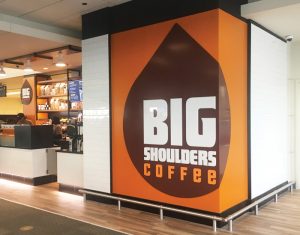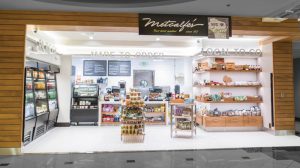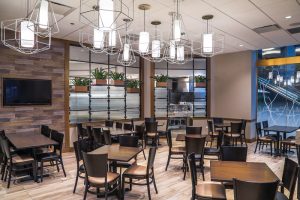— By Belinda O’Kelly —
How to captivate ‘captive’ audiences at airports with stunning design.
The thing that makes the design industry interesting is that our world as a context is constantly changing, and in turn, the changes influence design. The current innovations of the sharing economy, immersive technology and strides in wellness allow society to capitalize on the one fixed constant, the passage of time. There is now an elevated expectation on service, amenity and environment as we judge what is worth the time. There is a premium to be had on the ability to offer an experience. This has put much more pressure on the hospitality industry, and requires owners and operators to be on point, focusing on every detail.

Belinda O’Kelly
One unique place where this is becoming more evident is the airport. It used to be that airport amenities were limited to the bare necessities, and there was no pressure to make the experience particularly pleasant. There was a captive audience, so if you put out food, people would buy it. It could be expensive, unappetizing and limited. There was literally nowhere else to go. This was one reason being stuck at the airport used to be so unbearable. Slowly, with the addition of the airline upgraded lounges, and some competitive vendors, things started to change. Fast forward to now, and the landscape has been completely altered as operators are stepping up to the challenge to provide a good experience.
Operating an airport location is a truly unique challenge. You still have a captive audience, but now there is competition to not only make the experience great, but to change it up periodically. On the downside, there are the added complexities of getting goods in and out of the airport, difficulty in hiring qualified people, and typically abbreviated space and utility constraints. On the upside, there is the opportunity to showcase a brand and sell it to the world.
As we explore airports now, we see some welcome trends that are allowing smart operators to offer unique and exciting experiences. In the best cases, an airport offers the best of the city they represent.
Local Flavor
 Tapping into the local talent is one way operators can stay on trend without reinventing the wheel. Big Shoulders Coffee recently opened at Chicago’s Midway Airport, allowing more than 60,000 people a day to try coffee that Chicago has known was great for years. Large, iconic graphics highlighting local brands or the city itself help the airport to feel like an extension of the city surrounding it. Also, when possible, engaging local chefs or restaurants is a win for the airport, the city and the brand.
Tapping into the local talent is one way operators can stay on trend without reinventing the wheel. Big Shoulders Coffee recently opened at Chicago’s Midway Airport, allowing more than 60,000 people a day to try coffee that Chicago has known was great for years. Large, iconic graphics highlighting local brands or the city itself help the airport to feel like an extension of the city surrounding it. Also, when possible, engaging local chefs or restaurants is a win for the airport, the city and the brand.
Mix it Up
 Mixing retail and food experiences can help drive and improve revenue. Whether offering food products as souvenirs, offering convenience items like phone chargers at a bar that has charging on the bar top, or being a one-stop-shop for carry-out, diversifying revenue can help make a one-stop-shop for customers. Metcalfe’s at Dane County Regional Airport in Madison, Wisconsin, is a good example of this, offering local retail, food to order and great grab n’ go items. Also, designing in some flexibility for changing trends or periodic refreshes is essential. For example, if a food hall concept is being implemented, consider holding one or two pop-up locations where you can feature different chefs or restaurants seasonally.
Mixing retail and food experiences can help drive and improve revenue. Whether offering food products as souvenirs, offering convenience items like phone chargers at a bar that has charging on the bar top, or being a one-stop-shop for carry-out, diversifying revenue can help make a one-stop-shop for customers. Metcalfe’s at Dane County Regional Airport in Madison, Wisconsin, is a good example of this, offering local retail, food to order and great grab n’ go items. Also, designing in some flexibility for changing trends or periodic refreshes is essential. For example, if a food hall concept is being implemented, consider holding one or two pop-up locations where you can feature different chefs or restaurants seasonally.
Wellness
For road warriors, constant travel can be mentally and physically exhausting. Any healthy respite has an oasis-like appeal, and money is no object. Salads made and tossed in front of you, or even a quiet open area with comfortable seating, become particularly attractive. It is important to incorporate these Zen moments into the bustling airport setting; the contrast can be remarkable.
The Technology Advantage
We have only partially tapped into the role that technology plays in reshaping how we use airports. From the traveler’s perspective, small things like being able to order from a plane and walk by and pick it up on the way to another gate for a tight connection or being able to charge a phone and pay immediately at a concourse bar contributes to a much improved overall positive impact. The simple advancement of being able to order and pay off a tablet has allowed food and beverage service to explode outside of traditional borders. It is critical that we continue to think how changes in technology allow us to rethink how we use space. This is one of the most exciting areas where we will see dramatic change in the next 5 years.
Design Matters
It can be difficult to set a brand apart along a concourse of similar stalls; creating high impact and identity can take some design work. The IAH C concourse at George Bush Intercontinental Airport in Houston has some great examples. Embers, An American  Steakhouse has huge sweeping sculptural cables that draw your attention to the restaurant, which looks like a standalone location — completely different from the typical airport inline site. All of the restaurants along the C concourse have some identity — they have lighting, furniture and case goods that match their look, making you feel like you are part of the experience. Also, with new technology in loss prevention, they are able to create some retail experiences that are completely open — no walls around them. This really starts to give an open feeling to the gate area.
Steakhouse has huge sweeping sculptural cables that draw your attention to the restaurant, which looks like a standalone location — completely different from the typical airport inline site. All of the restaurants along the C concourse have some identity — they have lighting, furniture and case goods that match their look, making you feel like you are part of the experience. Also, with new technology in loss prevention, they are able to create some retail experiences that are completely open — no walls around them. This really starts to give an open feeling to the gate area.
Sustainability
Anything that can improve the amount of waste generated by an airport is good, but there are a few small things that have a big impact. To encourage travelers to bring their own refillable water bottle or coffee thermos, airports provide fill up stations and vendors provide discounts for using your own cup. Composting is starting to take hold, but the ideal commitment is airport wide and can be costly. Designing for recycling and composting containers needs to be considered and involves a larger scale commitment.
Nothing compares to an airport for global brand exposure; airports can also be an essential ambassador for the culture, music, food and products of the host city. As operators continue to take advantage of this opportunity, our time stuck at the airport only gets better.
— Belinda O’Kelly is a founding principal of O’Kelly Kasprak, an architecture and design firm specializing in the hospitality industry. Email: [email protected].
